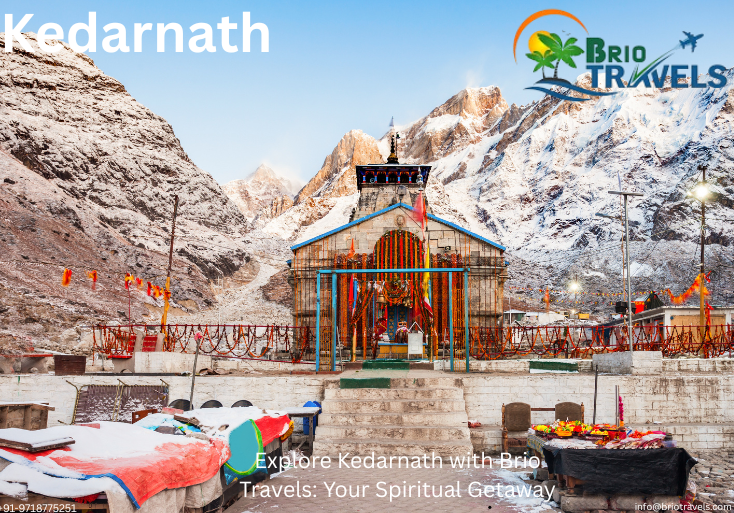Ultimate Kedarnath Travel Guide for Pilgrims and Nature Lovers
Kedarnath Travel Guide: A Holy Himalayan Trip
Kedarnath is one of India’s most sacred pilgrimage sites situated in the Garhwal Himalayas in Uttarakhand. Situated at an altitude of 11,755 feet above sea level, the temple is dedicated to Lord Shiva, and it is part of the Char Dham Yatra. The temple generally remains open to pilgrims from Akshaya Tritiya to Kārtik Pūrṇimā each year-that means from April to November.
Planning Your Visit
The wiser choice would be to take a Kedarnath tour package so that one may grasp its entirety. These sorts of packages usually include transport, accommodations, and guided tours, hence smoothening one’s stay. May and June are the best months to visit as the weather is clear and moderately warm.
Access and Travel Tips
It is a 16-km uphill trek to Kedarnath. Again for convenience, a helicopter service is also available from Sonprayag and can significantly minimize travel time. Ensuring beforehand booking is most important, as well as being prepared for an altitude.
Choosing a Good Travel Agency
Choosing the best travel agency in India is a step that can elevate your Kedarnath experience. Agencies specializing in Himalayan travel and with good reviews from fellow pilgrims are preferable. These agencies assist in arranging permits, and accommodations, and also impart knowledge about the culture and history of this exquisite land.
The trip to Kedarnath is more than a journey-it is a spiritual voyage. Fully characterized by perfect planning and suitable guidance will ensure that your trek to this sacred place is both fulfilling and memorable.
Spiritual Significance of Kedarnath
Historical Importance
Kedarnath has great significance in the Hindu tradition as one of the 12 Jyotirlingas of Shiva. It is said that after the Kurukshetra war, the Pandavas sought Shiva’s blessings for their atonement.
Shiva tried to hide in the Garhwal region in the form of a bull. When Bhima tried to catch hold of the bull, it simply disappeared, leaving behind its hump, which is worshipped at Kedarnath.
Temple Detail
Built with huge stone slabs, the temple is at an elevation of 3,583 m, having a pyramidal spire underlined by a gigantic conical rock slab worshipped as the Sadashiva form of Lord Shiva. The Char Dham Yatra as well as the Panch Kedar pilgrimage routes include famous temples, connecting them in terms of their spiritual importance.
Festivals and Rituals
Maha Shivaratri is celebrated as a major festival at Kedarnath, during which devotees fast and maintain night-long vigils, offering prayers to Lord Shiva.
They conduct abhishekam of the sacred lingam with milk, honey, and water while chanting Vedic hymns. The temple remains open from April till November and closes during the harsh winter months.
A Kedarnath travel guide can provide detailed information to those planning their visit, including temple timings, rituals, and travel arrangements.
Exploring Kedarnath tour packages can systematize the pilgrimage so as to make it highly rewarding spiritually. Consulting the best travel agency in India for Himalayan pilgrimages will add to the experience through professional guidance and assistance.
Best Time of Visiting Kedarnath in 2025
Best Months
The perfect time to visit Kedarnath is from May to mid-June and September to mid-November. During these times, pleasant weather prevails, offering access to the region for the pilgrims and trekkers. In 2025, the Kedarnath Temple will be open on May 2. The temple will be open until the early days of November, after which it shuts down for the winter season.
In the Monsoons
The monsoons of July and August are not any friend of Kedarnath tourism. Heavy rainfall will strike the region, making the paths slippery, and the danger of landslides will increase. Such adverse conditions make travel dangerous and certainly not enjoyable.
Weather Patterns
Summer May-June): Temperature ranges from 5°C to 20°C, clear skies, and moderate temperature, ideal for trekking and sightseeing.
Monsoon (July-August): Temperature ranges from 12°C to 18°C, rains occur together with landslides, so it is very challenging for travelers.
Autumn (September to October): Temperature ranges between 5°C to 15°C, cool weather, and suitable for pilgrimage.
Winter (November–March): It comes with temperatures remaining below zero degrees Celsius and heavy downpours of snow, thus making it closed and inaccessible for travelers.
Travel Tips
Plan your visit during the suggested months for an accident-free and enriching experience. Associating yourself with the best travel agency in India can assist immensely in the arrangement of your entire trip so as to keep you safe and comfortable.
The Kedarnath Trekking Guide
Thorough Trek Overview
The trek from Gaurikund to Kedarnath Temple, 16–18 kms, is more of a spiritual journey through the majestic Garhwal Himalayas. The trek required 6 to 8 hours or more, depending on the fitness of the individual or on an unfavorable weather day.
The difficulties range from moderate to hard with proper signage for the route and good facilities along the way.
Route Breakup
Gaurikund to Jungle Chatti (4 km): An initial 4-km uphill trek to Jungle Chatti. This stretch is very popular and can be traversed on foot, or some prefer resorting to ponies or palkis. Basic amenities are available here to take a short break.
Jungle Chatti to Bheembali (3 km): The trek for another 3 km involves a combination of uphill and flat terrain. Facilities such as GMVN tents, restrooms, and drinking water are available here, making it a well-deserved resting place or place to chose for overnight stay.
Bheembali to Linchauli (4 km) : Another 4 km trek brings one to Linchauli, offering beautiful views of the Mandakini River. The Medical facilities and accommodations are also available here.
Linchauli to Kedarnath Base Camp (4 km): The last 4 km trek up to the base camp comes steadily and richly rewarding. Staying overnight here is suggested for acclimatizing to the altitude and enabling you to avoid exhaustion.
The last 1 km to the temple is a gentle uphill climb, making early hours the best time to avoid queues. Trekking Tips
Due to changing terrains, wear a high-ankled, waterproof trekking shoe.
Carry your first aid box, any regular medications, and a valid photo ID for registration.
Register for Char Dham Yatra at counters in Haridwar or Rishikesh before commencing the trek.
For a more comfortable travel experience, one should opt for Kedarnath tour packages with the best travel agency in India. These packages provide transportation, accommodation, and guiding services to ensure safety and enrichment.
Alternative Travel Options to Kedarnath
Helicopter Services
Alternative Methods of Getting to Kedarnath Helicopter Services If you are looking for another option to your trek as a travel option, helicopter services to Kedarnath are provided from many different helipads.
You’re still going to travel over 50km by helicopter so the travel will quite literally remain a unique experience. Also, this method of travel is definitely scenic as you can’t beat reducing the travel time and the physical exertion in getting to Kedarnath by foot.
Booking Information
Booking Instructions The first step for pilgrims in booking helicopter tickets will be to successfully register for the Char Dham Yatra at the official Uttarakhand Tourism website. Once you have completed this step, pilgrims can then book helicopter tickets on the IRCTC Heli Yatra website.
Each of the Phata, Sirsi and Guptkashi, air to Kedarnath, will have a round trip fare of between ₹6,061 and ₹8,533, depending on where you depart from.
Safety Measures
Safety Safety is a significant consideration when traveling to Lower Kedarnath. It is well known that weather can vary and therefore all helicopter flights will only take flight if the weather is good and will discontinue immediately in the event of adverse weather conditions.
In addition to this, twin-engine helicopters are mandatory standards to adhere to criteria of travel to Kedarnath safety protocols. If you want to make it easy just reach out to the best travel agency in India for Kedarnath to help you book a tour package for your trip.
The tours will typically include transportation to the helipad, hotel stays, and guidance services; thus ensuring the travel os assured and meaningful.
Accommodation Options for Kedarnath Yatra
In Kedarnath,
There is little to nowhere to stay while in Kedarnath and Gaurikund because it is a high-altitude area. We can choose to stay in GMVN guest houses, dharamshalas, and tent options (only a few dharamshalas). The only notable dharamshalas near the temple are Gayatri Bhawan, Rajasthan Seva Sadan, and Punjab Sindh Awas.
They are located within 100 meters of the Temple. These dharamshalas offer basic amenities such as clean rooms, and simple vegetarian meals, but the amenities are very basic, and rooms are severely limited during peak seasons.
In Gaurikund and Sonprayag,
As for staying in Gaurikund or Sonprayag, it provides better facilities and a little less hassle of getting to the trek starting point. Gaurikund and Sonprayag have a variety of stay options for everyone from budget guesthouses to mid-range hotels.
Aditya Guest House and WildHimalayas.com campsite offer comfort with basic amenities. Choose your own adventure!
Booking Tips
It is always best to book your stay well in advance, and as you would guess, it is more difficult during this travel time of Char Dham Yatra (generally between May-June and September to November). This helps with availability and better better planning around your journey. –
Over all, if you want a more comfortable journey, you can always look for Kedarnath tour packages with the best travel agency in India. These packages usually organize your transport, stay & service, doing this will definitely make the trip…… safer and more enriching!
What to Bring for Kedarnath Yatra
Clothes
Bring warm layers, including thermal wear, woolens , and waterproof jackets. Remember gloves, woolen hats, and moisture wicking socks, too! Weather can vary widely.
Footwear
Wear high-ankle waterproof shoes that provide good grip when trekking in the mountains. Bring comfortable slip resistant sandals, so you can wear those when you visit temples where footwear needs to be removed.
Essentials
Bring a valid photo ID. A Char Dham registration slip. Some groups may need a medical certificate. Check if you are in that group.
Bring a first aid kit, flashlight, power bank, water bottle, and high-energy snacks. Trekking poles can also be an added help when trekking.
If you follow these rules for preparation, you will be able to have a safer and more enjoyable Kedarnath Yatra!
Exploring Kedarnath and Surroundings
Bhairavnath Temple
Bhairavnath Temple is located nearby Kedarnath Temple and it provides beautiful views of the surrounding mountains. Bhairavnath Temple is dedicated to Bhairav the caretaker deity of Kedarnath which attracts many pilgrims looking to be blessed and peaceful.
Tungnath and Chandrashila
Tungnath is the highest of the Shiva temples in the world and it is one of the Panch Kedar circuit. A trek from Tungnath leads to Chandrashila peak which stands at 3,690m where trekkers can catch of views of the different Himalayan ranges including Nanda Devi and Trisul.
Chorabari Tal
Chorabari Tal (also called Gandhi Sarovar) is a beautiful lake, located at an altitude of 3,900m. The lake was part of a glacier but had been destroyed from it by floods in 2013. To this day, it is a peaceful place of reflection that has beautiful views of mountains surrounding it.
Sonprayag
Sonprayag is a small village located at the convergence of the Mandakini and Basuki rivers. The convergence here is sacred and pilgrims believe by taking a dip in here they can be cleansed of sins. The village is base for trekking to Kedarnath and is peaceful place to stop and rest before moving on.
Guptkashi
Guptkashi is a small settlement situated at a midway point to Kedarnath, with varied temples and a scenic backdrop. The ancient Vishwanath Temple is dedicated to Lord Shiva and is similar in design to the famous Shiva temple in Varanasi.
Guptkashi has a very strong religious significance and shows that this area has a rich cultural background.
If you want the full experience, be sure to check out Kedarnath tour packages offered by the best travel agency in India.
Many of these tour packages often incorporate a visit to these surrounding attractions if you want the full pilgrimage experience.
Pilgrim and Trekker Safety Tips
Physical Preparation
Start exercising at least a month before your travel. Brisk walking, slow jogging, or running up the stairs can build up stamina. Stamina will hold you in wooden stead during the 16–18 km trek to Kedarnath.
Travel Insurance
Choose a comprehensive travel insurance policy that also covers high-altitude trekking. This, in turn, insures you in case of any unforeseen medical emergency or cancellation of trip. A small premium paid for a great peace of mind.
Health Precautions
Attend to a basic health check-up before beginning the journey. Those having pre-existing medical conditions must seek professional medical consultation. Keep your medications and prescriptions handy. Drink lots of fluids; no alcohol, no caffeine.
Emergency Contacts
Local emergency contact numbers and addresses of nearby hospitals must be kept handy. Make sure to share your itinerary with a trusted person. It may save your life.
Environmentally Responsible
Maintain the sanctity of the environment; don’t litter; throw your trash off in that manner. All retain the charm of Kedarnath for future pilgrims. Your actions impact the destiny of this holy place.
For an encompassing experience, think of Kedarnath tour packages being offered by the preeminent travel firm of India. They mostly include safety briefings, guided trekking, and permits making the journey safe and enriching.
Final Thoughts on the Kedarnath Yatra
Kedarnath Yatra is not just a yatra; it is a transformative journey. Located in the Garhwal Himalayas, Kedarnath has a peaceful environment for self-reflection and spiritual development.
The scene of the grand Kedarnath Temple, which is one of the 12 Jyotirlingas of Lord Shiva, and the surrounding area, is one example of extreme faith and devotion.
The natural beauty of Kedarnath is equally stunning. The breathtaking sight of the snow-capped Himalayas and serene Mandakini River provide a unique opportunity for the traveler to witness beauty and tranquility, whether high above in the mountains or near the river below.
The peaceful scene also allows travelers time and space to reflect and connect to nature.
Preparation is essential for a successful journey. The preparation for the journey includes the physical aspect of successfully walking the distance of 16 – 18 km (from Gaurikund to Kedarnath).
Brace yourself, the trek is challenging (at least for me) – tough hills, high altitudes, quickly changing weather. Furthermore, the snow-capped terrain became unbearable – and since we did not book lodging in advance – the weather, temperature, bits of snow, and altitude presented hardship.
The pre-arrangement of accommodation and transportation becomes prudent – especially with travel during holiday seasons (ie. Easter, Diwali, summer holidays, etc.) -and if your weather becomes quite unpredictable, this quest for peaceful areas becomes complicated – if lodging is not reserved – particularly with long distances to walk (especially at night).
Respecting and honoring local customs, including the area, as well as each traveler’s preferred methods of spirituality, contribute positively to the pilgrimage.
In conclusion, the Kedarnath Yatra is an opportunity to combine spirituality with natural beauty. Hopefully, this content suggests preparation – with care, respect, and commitment, the spiritual experience will carry through long after the journey has ended.








